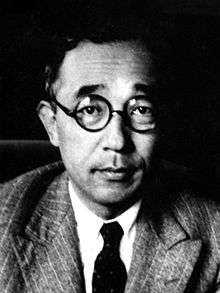Shimoyama incident
The Shimoyama incident (下山事件, Shimoyama jiken) was an incident in Japan in 1949, which involved the disappearance and death of Sadanori Shimoyama (下山 定則, Shimoyama Sadanori, born July 23, 1901), the first president of Japanese National Railways. He disappeared on his way to work, July 5, 1949, and his body was found the next day.[1]
Following the discovery of his body, the media offered conflicting explanations involving suicide and murder, while the police did not publicly report the results of their investigation, which was then ended.[1] The Mitaka incident, the Matsukawa derailment, and the Shimoyama incident occurred within one month of one another, and together are known as JNR's Three Big Mysteries.[2]
Background
Sadanori Shimoyama, bureaucrat of Ministry of Transport (former Ministry of Railways), was appointed the first president of JNR when it was established on June 1, 1949. Under the Dodge Line policy of the government, Shimoyama was responsible for drastic personnel cutbacks of JNR, as a part of which on July 4, 1949 he released a list of about 30,000 employees to be fired.[1]

On the morning of next day, July 5, Shimoyama left his home in Ōta, Tokyo around 8:20. On his way to work, he instructed the driver to stop at the Mitsukoshi Department Store in Nihonbashi.[2] Having arrived at the store before its opening, they returned to a Chiyoda Bank office (now The Bank of Tokyo-Mitsubishi UFJ) in front of Tokyo Station. They then followed a circuitous route back to the Mitsukoshi store. Around 9:37 AM, Shimoyama again got out of the official car, telling the driver to wait for five minutes.[1] He quickly entered the Mitsukoshi. This was the last he was heard from.
Normally, Shimoyama arrived at JNR headquarters before 9 AM and was greeted by his secretary. On the day of his disappearance, in the tense atmosphere of impending personnel cutbacks, there was an important meeting scheduled at 9 AM. His failure to arrive, after confirming from home that he would be there, caused a great stir at JNR headquarters, and the police were contacted. The investigation began as a missing persons case. On July 6, past 12:30 AM, Shimoyama's dismembered body was found on the Jōban Line between Kita-Senju Station and Ayase Station. He had been hit by a train.[1]
After the disappearance
After the disappearance, an individual fitting Shimoyama's description was reported seen first in the Mitsukoshi department store in Nihombashi,[3] then riding on a Ginza Line subway train bound for Asakusa. In the Mitsukoshi store, many people reported having seen him.
After 1:40 PM, the individual spoke with a station attendant at Tobu Railway's Gotanno Station, close to where the body was discovered. Following that, from 2 PM until some time past 5 PM, he stopped at Matsuhiro Ryokan, close to the station. There were many reports of a man with Shimoyama's height and clothing walking south along the Tōbu Isesaki Line from 6 PM until after 8 PM from Gotanno toward the spot in which the body was found.
Pre- or postmortem dismemberment

Found on the outbound track of the Jōban Line, it was determined that Shimoyama's body had been severed around 20 minutes after midnight by outbound freight train No. 869, pulled by locomotive D51 651. The official autopsy was led by Tokyo University professor of forensic medicine Tanemoto Furuhata. Based on the injuries to the body, it was determined that Shimoyama died prior to being hit by the train. The autopsy itself was performed by Furuhata's colleague Naoki Kuwashima.
Although a specific cause of death was not established, blood loss (at another location) was possible due to the lack of blood on the body and at the scene. Additionally, in some parts of the body life-threatening internal bleeding was found which could have been caused only by considerable force, such as kicking.
On the other hand, a Tokyo municipal coroner who had examined the body at the scene believed that Shimoyama's death was suicide. However, the internal bleeding observed in the remains of Shimoyama was also consistent with being hit by a train, and investigators would not have been able to observe blood at the scene because it was raining. As such, these as facts are not useful to support a murder theory.
Keio University professor Nakadate Kyūhei believed that Shimoyama was alive when hit by the train, although he never saw the body. These theories stand in opposition to one another. On August 30, 1949, Furuhata, Nakadate, and Kyōsuke Komiya of Nagoya Medical School were called to testify before the Committee on Judicial Affairs of the Diet's House of Representatives, and in doing so brought the Diet and the world of forensic medicine into the controversy.
In response to the committee's questions, Furuhata stated that "Kuwashima still cannot officially declare this a murder or suicide. He has stated only that the body was dismembered after death. The investigation is still underway, and those who know nothing of it but make deductions anyway are unscientific and taking liberties."
In art and media
- The character of Noriyuki Shimokawa in Osamu Tezuka's manga Ayako is modeled on Sadanori Shimoyama.[4]
- The Shimoyama incident is one of the central mysteries in Naoki Urasawa's seinen manga Billy Bat.
See also
References
- Shibata, Tetsutaka (May 19, 2009). 振り返る昭和 昭和24年 戦後最大の謎、下山事件 [Playback Showa 1949 - Shimoyama Incident, the biggest mystery after the war] (in Japanese). Archived from the original on March 23, 2014. Retrieved March 23, 2014.
- https://www.tokyoweekender.com/2018/05/the-three-big-rail-mysteries-that-defined-japans-summer-of-1949/
- https://www.japanpowered.com/history/the-japanese-national-railways-incidents-enduring-mysteries-from-post-war-japan
- Tezuka, Osamu (2013). Ayako. New York City: Vertical. p. 79. ISBN 9781935654780.